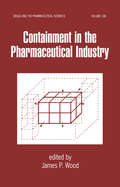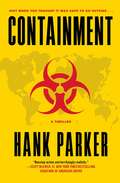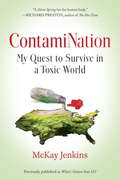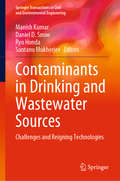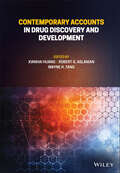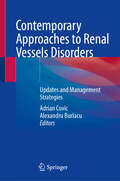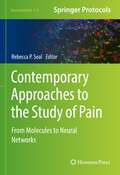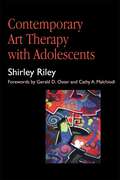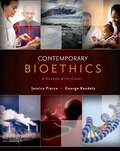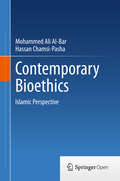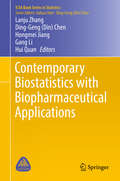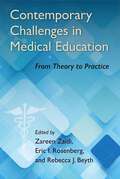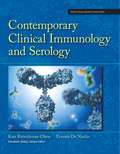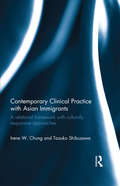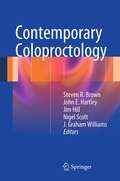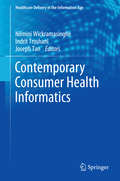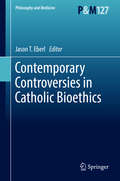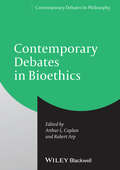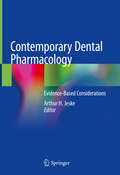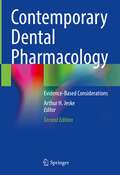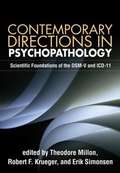- Table View
- List View
Containment in the Pharmaceutical Industry (Drugs And The Pharmaceutical Sciences Ser. #108)
by James P. WoodDelivering an encompassing overview of the factors, varieties, and applications determining product containment, this concise reference provides authoritative information on containment processes. It reviews the historical context, definition, evolution, and application of containment technology, analyzes a variety of containment techniques in new
Containment: A Thriller
by Hank ParkerFrom a former US government advisor on agroterrorism comes a ripped-from-the-headlines debut thriller about a global plot to release a deadly virus and the elite response team who must try to stop it.When a gruesome new tick-borne virus breaks out near a major US city and the outbreak is traced to an extremist group in Southeast Asia, the race to stop a global bioterrorism conspiracy is on. Government epidemiologist Mariah Rossi must leave the safety of her lab to help fellow scientist and covert CIA agent Curt Kennedy track the disease back to its source. Their worldwide net leads them to an underground lab in the jungles of the Philippines, then to a deadly and climactic battle in coral reefs near Malaysian Borneo, and finally to London and back to America, where the virus must be contained. For fans of Michael Crichton and Richard Preston, this chilling, realistic thriller is a terrifying reminder of how vulnerable humans are to biological threats—and in this instance, just one tick bite away from catastrophe.
ContamiNation
by Mckay JenkinsAn investigation into the dangers of the chemicals present in our daily lives, along with practical advice for reducing these toxins in our bodies and homes, from acclaimed journalist McKay Jenkins. A few years ago, journalism professor McKay Jenkins went in for a routine medical exam. What doctors found was not routine at all: a tumor, the size of a navel orange, was lurking in his abdomen. When Jenkins returned to the hospital to have the tumor removed, he was visited by a couple of researchers with clipboards. They had some questions for him. Odd questions. How much exposure had he had to toxic chemicals and other contaminants? Asbestos dust? Vinyl chlorine? Pesticides? A million questions, all about seemingly obscure chemicals. Jenkins, an exercise nut and an enviro-conscious, organic-garden kind of guy, suddenly realized he'd spent his life marinating in toxic stuff, from his wall-to-wall carpeting, to his dryer sheets, to his drinking water. And from the moment he left the hospital, he resolved to discover the truth about chemicals and the "healthy" levels of exposure we encounter each day as Americans. Jenkins spent the next two years digging, exploring five frontiers of toxic exposure--the body, the home, the drinking water, the lawn, and the local box store--and asking how we allowed ourselves to get to this point. He soon learned that the giants of the chemical industry operate virtually unchecked, and a parent has almost no way of finding out what the toy her child is putting in his or her mouth is made of. Most important, though, Jenkins wanted to know what we can do to turn things around. Though toxins may be present in products we all use every day--from ant spray, perfume, and grass seed to shower curtains and, yes, baby shampoo--there are ways to lessen our exposure. ContamiNation is an eye-opening report from the front lines of consumer advocacy.
Contaminants in Drinking and Wastewater Sources: Challenges and Reigning Technologies (Springer Transactions in Civil and Environmental Engineering)
by Manish Kumar Daniel D. Snow Ryo Honda Santanu MukherjeeThis volume takes a multidisciplinary approach to study and evaluate the global human vulnerability to the exposure of contaminants of emerging concern (CECs) in the natural environment. It provides a comprehensive resource on structurally diverse groups of chemical compounds that have adverse effects on the aquatic environment. It explores the global strength, environmental status, chemical risk assessment and management strategies of CECs with relevant modern techniques. The principle focus is on concurrent emerging water quality issues. It defines the impacts of the environmental exposure of trace concentrations of CECs and/or their metabolites and discusses possible technological advances to combat the emerging pollutants. It will be useful to researchers, multi-stakeholder expert groups, policymakers, and graduate students.
Contaminated Water Supplies at Camp Lejeune: Assessing Potential Health Effects
by National Research Council of the National AcademiesIn the early 1980s, two water-supply systems on the Marine Corps Base Camp Lejeune in North Carolina were found to be contaminated with the industrial solvents trichloroethylene (TCE) and perchloroethylene (PCE). The water systems were supplied by the Tarawa Terrace and Hadnot Point watertreatment plants, which served enlisted-family housing, barracks for unmarried service personnel, base administrative offices, schools, and recreational areas. The Hadnot Point water system also served the base hospital and an industrial area and supplied water to housing on the Holcomb Boulevard water system (full-time until 1972 and periodically thereafter). This book examines what is known about the contamination of the water supplies at Camp Lejeune and whether the contamination can be linked to any adverse health outcomes in former residents and workers at the base.
Contemplative Science: Where Buddhism and Neuroscience Converge
by B. Alan Wallace Brian HodelB. Alan Wallace, renowned Buddhist scholar, integrates the contemplative methodologies of Buddhism and Western science into a single discipline: contemplative science. The science of consciousness investigates the mind through Buddhist contemplative techniques, such as shamatha, an organized, detailed system of training the attention. Just as scientists make observations and conduct experiments with the aid of technology, contemplatives have long tested their theories with the help of highly developed meditative skills of observation and experimentation. Contemplative science allows for a deeper knowledge of mental phenomena, and its emphasis on strict mental discipline counteracts the effects of conative (intention and desire), attentional,cognitive, and affective imbalances. Just as behaviorism, psychology, and neuroscience shed light on the cognitive processes enabling us to survive and flourish, contemplative science offers a groundbreaking perspective for expanding our capacity to realize genuine well-being. It also forges a link between the material world and the realm of the subconscious, transcending a traditional science-based understanding of the self.
Contemplative Science: Where Buddhism and Neuroscience Converge (Columbia Series in Science and Religion)
by B. Alan WallaceScience has long treated religion as a set of personal beliefs that have little to do with a rational understanding of the mind and the universe. However, B. Alan Wallace, a respected Buddhist scholar, proposes that the contemplative methodologies of Buddhism and of Western science are capable of being integrated into a single discipline: contemplative science.The science of consciousness introduces first-person methods of investigating the mind through Buddhist contemplative techniques, such as samatha, an organized, detailed system of training the attention. Just as scientists make observations and conduct experiments with the aid of technology, contemplatives have long tested their own theories with the help of highly developed meditative skills of observation and experimentation. Contemplative science allows for a deeper knowledge of mental phenomena, including a wide range of states of consciousness, and its emphasis on strict mental discipline counteracts the effects of conative (intention and desire), attentional, cognitive, and affective imbalances.Just as behaviorism, psychology, and neuroscience have all shed light on the cognitive processes that enable us to survive and flourish, contemplative science offers a groundbreaking perspective for expanding our capacity to realize genuine well-being. It also forges a link between the material world and the realm of the subconscious that transcends the traditional science-based understanding of the self.
Contemporary Accounts in Drug Discovery and Development
by Xianhai Huang Robert G. Aslanian Wayne H. TangCONTEMPORARY ACCOUNTS IN DRUG DISCOVERY AND DEVELOPMENT A useful guide for medicinal chemists and pharmaceutical scientists Drug discovery is a lengthy and complex process that typically involves identifying an unmet medical need, determining a biological target, chemical library screening to identify a lead, chemical optimization, preclinical studies and clinical trials. This process often takes many years to complete, and relies on practitioners’ knowledge of chemistry and biology, but also—and perhaps more importantly—on experience. Improving the success rate in discovery and development through a thorough knowledge of drug discovery principles and advances in technology is critical for advancement in the field. Contemporary Accounts in Drug Discovery and Development provides drug discovery scientists with the knowledge they need to quickly gain mastery of the drug discovery process. A thorough accounting is given for each drug covered within the book, as the authors provide pharmacology, drug metabolism, biology, drug development, and clinical studies for every case, with modern drug discovery principles and technologies incorporated throughout. Contemporary Accounts in Drug Discovery and Development readers will also find Case histories used as an engaging way of learning about the drug discovery/development process Detailed biological rational and background information, drug design principles, SAR development, ADMET considerations, and clinical studies The full history of individual marketed small molecule drugs Coverage of drug candidates that have passed Phase I clinical trials with different modalities, such as antibody drug conjugates (ADC), proteolysis-targeting chimera (PROTAC), and peptide drugs The application of new technologies in drug discovery such as DNA-encoded libraries (DEL), positron emission tomography (PET), and physics-based computational modeling employing free energy perturbation (FEP) Contemporary Accounts in Drug Discovery and Development is a helpful tool for medicinal chemists, organic chemists, pharmacologists, and other scientists in drug research and process development. It may be considered essential reading for graduate courses in drug discovery, medicinal chemistry, drug synthesis, pharmaceutical science, and pharmacology. It is also a useful resource for pharmaceutical industry labs, as well as for libraries.
Contemporary Approaches to Renal Vessels Disorders: Updates and Management Strategies
by Adrian Covic Alexandru BurlacuIn the last five years, there have been published novelties related to the management (e.g., diagnosis, drug treatment, minimally invasive interventional or surgical treatment) of renal vascular diseases or their consequences (e.g., arterial hypertension). In this volume we have added a chapter on the usefulness of knowledge of anatomy and anatomical variants in endovascular therapies or renal transplantation. We also presented an updated approach on paraclinical diagnostic techniques of the various renal vessels pathologies.This book offers current protocols for treating renal artery or vein thrombosis, using (or not) combinations of the new antithrombotics.As new data emerged concerning percutaneous interventions for renal artery stenosis, we comprehensively analyze published clinical trials to highlight the role of transcatheter renal artery stenting in contemporary cohorts of patients.Given the recent news regarding theupdated techniques and the evidence supporting the indications of renal denervation in resistant hypertension, this volume dedicates three chapters to the new devices, indications from 2023, and extra-hypertensive uses of RDN.
Contemporary Approaches to the Study of Pain: From Molecules to Neural Networks (Neuromethods #178)
by Rebecca P. SealThis volume contains experimental approaches that are currently revolutionizing our understanding of the neurobiology of pain. The chapters cover many cutting-edge methods including the identification of gene expression profiles, transcriptomes or translatomes, from individual cells or defined groups of cells in rodents and primates; the electrophysiological investigation of human tissues, such as human dorsal root ganglion neurons; ways to assess modality response profiles of neurons using calcium imaging in vitro and in vivo; and somatosensory behaviors in rodents using high-speed videography and machine learning. In the Neuromethods series style, the chapters include detailed advice from specialists to obtain successful results in your laboratory.Cutting-edge and comprehensive, Contemporary Approaches to the Study of Pain: From Molecules to Neural Networks is a valuable resource for scientists and researchers interested in making impactful contributions to our understanding of pain.
Contemporary Art Therapy with Adolescents
by Shirley Riley Cathy A MalchiodiContemporary Art Therapy with Adolescents offers practical and imaginative solutions to the multifaceted challenges that clinicians face when treating young people. The author fuses the contemporary theories of clinical treatment with the creative processes of art therapy to arrive at a synthesis which yields successful outcomes when working with adolescents. Clinicians of allied disciplines, particularly art therapists, will find practical suggestions for using imagery to enrich their relationships with teenaged clients. The process of using art-making therapeutically, and the challenges of applying creativity in the current mental health world, are explored. Shirley Riley reviews current theories on adolescent development and therapy, and emphasizes the primary importance of relying on the youths' own narrative in the context of their social and economic backgrounds. She has found this approach preferential to following pre-designed assessment directives as a primary function of art therapy. Family, group and individual treatment are examined, as is the adolescent's response to short- and long-term treatment in residential and therapeutic school settings. The book is firmly rooted in Riley's clinical experience of working with this age group, and her proven ability to combine contemporary theories of adolescent treatment with inventive and effective art expressions.
Contemporary Art Therapy with Adolescents
by Shirley RileyContemporary Art Therapy with Adolescents offers practical and imaginative solutions to the multifaceted challenges that clinicians face when treating young people. The author fuses the contemporary theories of clinical treatment with the creative processes of art therapy to arrive at a synthesis which yields successful outcomes when working with adolescents. Clinicians of allied disciplines, particularly art therapists, will find practical suggestions for using imagery to enrich their relationships with teenaged clients. The process of using art-making therapeutically, and the challenges of applying creativity in the current mental health world, are explored.Shirley Riley reviews current theories on adolescent development and therapy, and emphasizes the primary importance of relying on the youths' own narrative in the context of their social and economic backgrounds. She has found this approach preferential to following pre-designed assessment directives as a primary function of art therapy. Family, group and individual treatment are examined, as is the adolescent's response to short- and long-term treatment in residential and therapeutic school settings. The book is firmly rooted in Riley's clinical experience of working with this age group, and her proven ability to combine contemporary theories of adolescent treatment with inventive and effective art expressions.
Contemporary Bioethics: A Reader with Cases
by Jessica Pierce George RandelsContemporary Bioethics: A Reader with Cases is the most cutting-edge bioethics anthology/casebook available. Incorporating introductions, readings, and cases that span the breadth of the discipline, this exceptional volume captures the spirit of bioethics as a rich, exciting, and continuously evolving field. Addressing all of the essential topics--including abortion, reproductive ethics, end-of-life care, research ethics, and the allocation of resources--it also moves beyond the "classic" approach of other books by extending into timely and provocative issues like terrorism, cosmetic surgery, immigration, genetic manipulations, links between first- and third-world health, and--unique to this book--environmental sustainability and climate change. In addition, Contemporary Bioethics is the only book of its kind that includes both philosophical and religious perspectives. <p><p>The text opens with a substantial introduction that presents key ethical principles, theories, and methods and shows students how to use these tools to frame and address ethical dilemmas in medicine. Covering the brief yet captivating history of the field, the introduction also considers the role of religion in the development of bioethics and examines differences between secular and religious modes of argumentation. Each of the seven topical chapters contains an in-depth introduction, a selection of concise readings representing a diverse range of moral perspectives (including feminist, religious, secular, and third-world), discussion questions, and a collection of full-length and provocative case studies that enable students to further explore the issues. <p><p>Ideal for introductory courses in bioethics and biomedical ethics, Contemporary Bioethics is supplemented by a Instructor's Manual on CD and a Companion Website containing resources for both students and professors, including chapter summaries, additional cases with discussion questions, ideas for further reading, vocabulary flashcards, self-quizzes, and more.
Contemporary Bioethics: Islamic Perspective
by Mohammed Ali Al-Bar Hassan Chamsi-PashaThis book discusses the common principles of morality and ethics derived from divinely endowed intuitive reason through the creation of al-fitr' a (nature) and human intellect (al-'aql). Biomedical topics are presented and ethical issues related to topics such as genetic testing, assisted reproduction and organ transplantation are discussed. Whereas these natural sources are God's special gifts to human beings, God's revelation as given to the prophets is the supernatural source of divine guidance through which human communities have been guided at all times through history. The second part of the book concentrates on the objectives of Islamic religious practice - the maqa' sid - which include: Preservation of Faith, Preservation of Life, Preservation of Mind (intellect and reason), Preservation of Progeny (al-nasl) and Preservation of Property. Lastly, the third part of the book discusses selected topical issues, including abortion, assisted reproduction devices, genetics, organ transplantation, brain death and end-of-life aspects. For each topic, the current medical evidence is followed by a detailed discussion of the ethical issues involved.
Contemporary Biostatistics with Biopharmaceutical Applications (ICSA Book Series in Statistics)
by Gang Li Ding-Geng Din Chen Lanju Zhang Hui Quan Hongmei JiangThis edited volume presents current research in biostatistics with emphasis on biopharmaceutical applications. Featuring contributions presented at the 2017 ICSA Applied Statistics Symposium held in Chicago, IL on June 25 to 28, 2017, this book explores timely topics that have a high potential impact on statistical methodology and future research in biostatistics and biopharmaceuticals. The theme of this conference was Statistics for a New Generation: Challenges and Opportunities, in recognition of the advent of a new generation of statisticians. The conference attracted statisticians working in academia, government, and industry; domestic and international statisticians. From the conference, the editors selected 28 high-quality presentations and invited the speakers to prepare full chapters for this book. These contributions are divided into four parts: Part I Biostatistical Methodology, Part II Statistical Genetics and Bioinformatics, Part III Regulatory Statistics, and Part IV Biopharmaceutical Research and Applications.Featuring contributions on topics such as statistics in genetics, bioinformatics, biostatistical methodology, and statistical computing, this book is beneficial to researchers, academics, practitioners and policy makers in biostatistics and biopharmaceuticals.
Contemporary Challenges in Medical Education: From Theory to Practice
by Zareen Zaidi, Eric I. Rosenberg and Rebecca J. BeythWhile medical schools usually emphasize the teaching of advanced scientific fundamentals through a carefully planned, formal curriculum, few focus on the equally crucial “hidden curriculum” of professional attitudes, skills, and behaviors. This concise and practical guide helps educators effectively prepare students for seldom-taught issues that arise daily in the practice of clinical medicine. In this volume, experienced clinician-educators offer real-world examples of various pedagogical and clinical scenarios, providing evidence- and theory-based approaches to managing three areas of growth: professional development, professionalism, and teaching. Acknowledging human fallibility, the editors begin with a framework that institutions, educators, and learners can use to promote well-being, outlining strategies for mindfulness training, relaxation techniques, appreciative inquiry, narrative medicine, and positive psychology. They then apply these strategies to additional developmental topics like failure, burnout, and improving resilience, social identity formation, and graceful self-promotion. The editors move on to discuss power differentials. They suggest ways of combatting microaggressions faced by women and minorities, fostering a safe learning environment where learners feel comfortable advocating in the setting of ethical dilemmas, recognizing and avoiding student mistreatment, and encouraging humility. They close with implications for the classroom, explaining the benefits and pitfalls of electronic health records and social media, the positive and negative attributes of role models, how to comfortably navigate controversial topics like gun ownership and abortion, and teaching empathy. With helpful infographics and case studies, this volume is a valuable resource for frontline educators who wish to help learners navigate the transition from layperson to medical professional.
Contemporary Clinical Immunology and Serology
by Kate Rittenhouse-Olson Ernesto De NardinThis complete, up-to-date introduction to immunology takes students from basic vocabulary through common immunoassays to closer consideration of the specific diseases that require immunologic methods of diagnosis. CLINICAL IMMUNOLOGY AND SEROLOGY presents today's newest professional techniques, thoroughly preparing students to work in modern clinical immunology laboratories, understand the data generated there, and apply the conclusions to deliver superior patient care. Full-color charts and illustrations engage students and enhance comprehension, and the text's content has been extensively classroom-tested. It contains the most up-to-date information to accurately reflect what in done in the clinical immunology laboratory. Every chapter contains review and critical thinking questions, as well as a detailed case study.
Contemporary Clinical Practice with Asian Immigrants: A Relational Framework with Culturally Responsive Approaches
by Tazuko Shibusawa Irene ChungMany first and second generation Asian immigrants experience acculturation challenges to varying extents. These challenges, such as language barriers, racial discrimination, underemployment, the loss of support networks and changes in family role and structure, may exacerbate a myriad of mental health issues. In addition, their help-seeking behaviour, as shaped by a general adherence to a collectivistic worldview and indirect communication style, often creates challenges for the practitioners who are trained under a Western practice modality. Drawing on literature from English-speaking countries with sizeable Asian immigrant populations such as the United States, Australia, New Zealand, Canada, and the United Kingdom, this text is designed especially for clinicians and students working with Asian immigrant populations. It discusses the therapeutic process in psychotherapy and counselling with these clients, exploring both key psychodynamic constructs and social systemic factors. Building on contemporary relational theory, which emphasizes the centrality of the helping relationship and sensitivity to the client’s subjective realities, the book demonstrates how western-based concepts and skills can be broadened and applied in an Asiacentric context, and can be therapeutic even in social service and case management service settings. There are chapters on issues such as domestic violence, intergenerational conflicts, depression amongst elders, and suicide, discussing the prevalence and nature of the mental health issues and each containing case vignettes from various Asian ethnic groups to illustrate the application of relational approaches. This book is an important cross-cultural reference for practising social workers and counsellors as well as for social work students undertaking clinical practice courses.
Contemporary Coloproctology
by Steven Brown John E. Hartley Nigel Scott J. Graham Williams Jim HillContemporary Coloproctology covers colorectal surgery, as practiced today, in an easily accessible format with emphasis on bringing key facts rapidly into focus. It is ideal reading both for the medical trainee and the practicing colorectal surgeon. As well as a succinct presentation of the current colorectal knowledge base, each chapter contains practical advice and pearls of wisdom from established practicing clinicians. A unique feature of the format is the identification of key references and questions and scenarios that present real life decisions in colorectal surgery. Edited and authored by outstanding surgeons in their fields, this book brings the reader expertise in surgery and management across the various conditions encountered in coloproctology.
Contemporary Consumer Health Informatics (Healthcare Delivery in the Information Age)
by Nilmini Wickramasinghe Indrit Troshani Joseph TanThis innovative reference examines how consumer health informatics (CHI) can transform healthcare systems stressed by staffing shortages and budget constraints and challenged by patients taking a more active role in their care. It situates CHI as vital to upgrading healthcare service delivery, detailing the relationship between health information technologies and quality healthcare, and outlining what stakeholders need to learn for health IT systems to function effectively. Wide-ranging content identifies critical issues and answers key questions at the consumer, practitioner, administration, and staff levels, using examples from diverse conditions, countries, technologies, and specialties. In this framework, the benefits of CHI are seen across service domains, from individual patients and consumers to healthcare systems and global health entities. Included in the coverage: Use of video technology in an aged care environment A context-aware remote health monitoring service for improved patient care Accessibility issues in interoperable sharing of electronic health records: physician's perspective Managing gestational diabetes with mobile web-based reporting of glucose readings An organizing vision perspective for developing and adopting e-health solutions An ontology of consumer health informatics Contemporary Consumer Health Informatics combines blueprint and idea book for public health and health informatics students, healthcare professionals, physicians, medical administrators, managers, and IT practitioners.
Contemporary Controversies in Catholic Bioethics (Philosophy and Medicine #127)
by Jason T. EberlThis volume comprises various viewpoints representing a Catholic perspective on contemporary practices in medicine and biomedical research. The Roman Catholic Church has had a significant impact upon the formulation and application of moral values and principles to a wide range of controversial issues in bioethics. Catholic leaders, theologians, and bioethicists have elucidated and marshaled arguments to support the Church's definitive positions on several bioethical issues, such as abortion, euthanasia, and reproductive cloning. Not all bioethical issues, however, have been definitively addressed by Catholic authorities, and some Church teachings allow for differing applications in diverse circumstances. Moreover, as new biomedical technologies emerge, Church authorities rely on experts in science, medicine, philosophy, theology, law, and other disciplines to advise them. Such experts continue to debate issues related to reproduction, genetics, end-of-life care, and health care policy. This volume will be a valuable resource for scholars in bioethics or Catholic studies, who will benefit from the nuanced arguments offered based on the latest research. This volume is also instructive for students entering the field to become aware of the founding philosophical and theological principles informing the Catholic bioethical worldview.
Contemporary Debates in Bioethics (Contemporary Debates in Philosophy #27)
by Robert Arp Arthur L. CaplanContemporary Debates in Bioethics features a timely collection of highly readable, debate-style arguments contributed by many of today’s top bioethics scholars, focusing on core bioethical concerns of the twenty-first century. Written in an engaging, debate-style format for accessibility to non-specialists Features general introductions to each topic that precede scholarly debates Presents the latest, cutting-edge thoughts on relevant bioethics ideas, arguments, and debates
Contemporary Dental Pharmacology: Evidence-Based Considerations
by Arthur H. JeskeThis book on current approaches to the use of drugs in dentistry aims to equip practitioners with a sound understanding of both the scientific evidence for various interventions and the comparative efficacy of those interventions. The focus is on the drugs most commonly used in conjunction with dental treatment, including local anesthetics, analgesics, antibiotics, sedatives, and drugs for the management of medical emergencies. Summaries of the scientific evidence from the available published literature are provided, with assessment of the level and quality of the evidence base. A unique aspect of the book is its focus on current, evidence-based recommendations from professional organizations with regard to special topics, such as antibiotic prophylaxis, pediatric considerations, and management of medically compromised patients. Emphasis is placed on evidence from randomized controlled trials, systematic reviews and meta-analyses, and in order to further enhance the up-to-date nature of the book, each chapter includes guidance on online resources, such as useful non-commercial websites .
Contemporary Dental Pharmacology: Evidence-Based Considerations
by Arthur H. JeskeThis book on current approaches to the use of drugs in dentistry, now in an extensively revised second edition, aims to equip practitioners with a sound understanding of both the scientific evidence for various interventions and the comparative efficacy of those interventions. The focus is on the drugs most commonly used in conjunction with dental treatment, including local anesthetics, analgesics, antibiotics, sedatives, and drugs for the management of medical emergencies. Summaries of the scientific evidence from the available published literature are provided, with assessment of the level and quality of the evidence base. A unique aspect of the book is its focus on current, evidence-based recommendations from professional organizations with regard to special topics, such as antibiotic prophylaxis, pediatric considerations, and management of medically compromised patients. Emphasis is placed on evidence from randomized controlled trials, systematic reviews and meta-analyses,and in order to further enhance the up-to-date nature of the book, each chapter includes guidance on online resources, such as useful non-commercial websites.
Contemporary Directions in Psychopathology
by Robert Krueger Theodore MillonThis forward-thinking volume grapples with critical questions surrounding the mechanisms underlying mental disorders and the systems used for classifying them. Edited and written by leading international authorities, many of whom are actively involved with the development of DSM-V and ICD-11, the book integrates biological and psychosocial perspectives. It provides balanced analyses of such issues as the role of social context and culture in psychopathology and the pros and cons of categorical versus dimensional approaches to diagnosis. Cutting-edge diagnostic instruments and research methods are reviewed. Throughout, contributors highlight the implications of current theoretical and empirical advances for understanding real-world clinical problems and developing more effective treatments.
